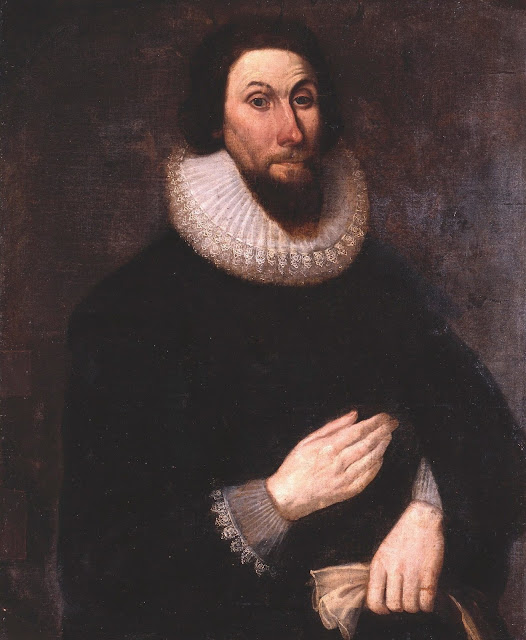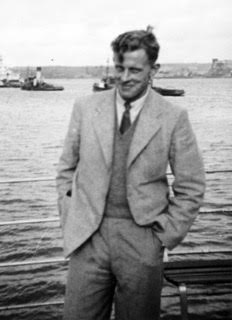AROUND THE TOWN AND OVER THE POND - 07: 'FROM BUDLEIGH TO BEVERLY'
Continued from
https://budleighpastandpresent.blogspot.com/2024/06/around-town-and-over-pond-06-other-east.html
AROUND THE TOWN AND OVER THE POND
A walk around Budleigh Salterton to interest transatlantic visitors. Every so often there’s a diversion which may inspire you to visit places like East Budleigh, Exeter, Sidmouth, Colyton or even places in the United States and Canada.
The walk is set out in parts. Here’s the seventh part:
Still at the Raleigh Wall.
0.7 FROM BUDLEIGH TO BEVERLY
The Salem 400+ logo Image credit: www.salem400.org
Roger Conant is perhaps best known for founding the city of Salem, originally called Naumkeag. Many other New England communities have celebrated or will celebrate their 400th anniversaries during the early 21st century; most have been careful to add that inclusive +. They recognise that there were thriving communities of Native Americans before the Europeans arrived.
As the publicity material puts it: ‘Salem 400+ commemorates Salem’s quadricentennial while acknowledging the preexisting indigenous community and explores the opportunities and connections of Salem’s multifaceted history while crafting a vision for current and future generations.’
Thanks to Salem historian Benjamin Shallop for posting the above news item on the Conant400 Facebook page
Roger is also credited with establishing the
nearby Massachusetts communities of Peabody, Danvers and Beverly.
The Burying Point Cemetery, Salem. Image credit: www.findagrave.com; Wikipedia
Top is a modern map showing the position of Beverly, NE of Salem. Below is the ‘Map of the Old Planters 1000 Acre Grant of 1635’ Image credit: Robert Raymond
In 1635, Roger Conant and four
other villagers, John Balch, Peter Palfrey, John Woodbury, and William Trask,
petitioned the town of Salem for a land grant on the other side of the river,
known as the ‘Bass River Side’. This grant was approved and each man was
allotted 200 acres of farmland, totalling 1,000 acres in all. These men and
their wives and children soon settled the new region, building homesteads in
what eventually became Beverly.
According to his biographer, Clifford K. Shipton, it was Conant who headed a petition dated 9 May 1659 seeking permission to establish and build a separate church for the convenience of the settlers on the other side of the Bass River from Salem.
‘Wee your petitioners,’ it began, ‘(being upwards of Sixty families, who by reason of our inconveniency of meeting publiquely on the Lords days at Salem towne, it being very troublesome and dangerous, to transport ourselves and families winter and sommer over the ferry) (…) crave and request That Your Worships would be pleased (…) that we may be a township or villedg of & by ourselves. (…) These things we leave to your wise consideration, hoping that your bowels will move towards us, in granting your poor petitioners requests.’
Seal of the town of Beverly, Massachusetts,
featuring a Puritan planter with a rifle in one hand, leaning against chopped
wood and trees to his left side. The town motto reads ‘Patri Simillima Proles’,
a Latin phrase roughly meaning ‘May we be as our children’. Image credit: Wikipedia
By 1671 the petition had been granted, and Bass River had become Beverly, named for some reason after the English town in Yorkshire. Local historians there did not know why the name had been chosen. Beverly would finally become a city in 1894.
The copy of the 1671 petition
addressed by Roger Conant to the General Court. Image credit: Dr Donna Seger
But for Roger Conant the new name had become a
problem, causing annoyance and embarrassment to him and his fellow-residents.
In another petition of 1671 to the General Court at Salem he wrote of ‘the
great dislike and discontent of many of our people for this name of Beverly,
because (wee being but a smale place) it hath caused on us a Constant nickname
of beggarly’.
Roger suggested an
alternative name which reveals his abiding attachment to his birthplace, and
which he felt would be more appropriate. As he pointed out, all those settlers
who were with him when he first arrived at Salem, ‘being all from the western part
of England, desire this western name of Budleigh’, the place ‘where myself was
borne.’
Sadly for Roger this petition was not
successful. A note of 1 June 1671 written on the document stated: ‘The
Magistrates having pursued and considered this request, see no cause to alter
the name of the place as desired, their brethren the deputies hereto
consenting’.
Portrait of the first governor of the
Massachusetts Bay Colony, John Endecott. Image credit: Wikipedia
Roger had been the respected leader of the Old Planters, mostly from Western England, who had come from Cape Ann to Naumkeag. However in 1628 his authority had diminished when the Massachusetts Bay Company established an outpost of its colony at Salem, appointing as governor the zealous Puritan Separatist John Endecott.
John Endecott cutting the cross out of the English flag, from William Cullen Bryant and Sydney Howard Gay - A popular history of the United States: from the first discovery of the western hemisphere by the Northmen, to the end of the first century of the union of the states; preceded by a sketch of the prehistoric period and the age of the mound builders, New York, 1876
Often characterised by historians as hot-headed, Endecott is remembered for dramatic acts such as his defacing of the English flag in an incident of around 1633, inspired by his belief that the St George's Cross was a symbol of the Papacy.
Engraving depicting Endecott's men landing on Block Island. Image credit: Wikipedia
A punitive expedition that he led in 1636 against a Native American settlement is considered to have started the Pecquot war and destroyed the Pecquot tribe.
The persecution of Quakers by New England Puritans: boring through the tongue with a hot iron was one of the punishments meted out to victims. Right is the statue commemorating Mary Dyer, one of four Quakers hanged on the orders of John Endecott. Image credit: wwe.historicipswich.net; www.youthquakenow.com
Later, in the 1650s he became notorious for his persecution of Quakers. The contrast in character between him and the ‘tolerant, mild and conciliatory’ Roger Conant is evident.
A 17th century portrait of John Winthrop, 2nd, 6th, 9th and 12th Governor of the Massachusetts Bay Colony Image credit: Wikipedia
Endecott himself was replaced as Governor when John Winthrop, one of the founders of the colony established by the Massachusetts Bay Company, sent a fleet of 11 ships carrying between 700 and 1,000 Puritans during the summer of 1630.
By the 1670s, Roger and his fellow-settlers from the West Country were far outnumbered by the largely Separatist Puritans who had dominated New England since the arrival of the Winthrop Fleet.
This replica of Arbella, the flagship of the Winthrop Fleet, was built for the 300th anniversary of Salem in 1930 in conjunction with Pioneer Village. It fell into disrepair and was dismantled in 1954. Image credit: Wikipedia
Most of the New Englanders who had arrived after the Winthrop Fleet of 1630 were not from the West Country but from areas such as Lincolnshire, Norfolk and Yorkshire. They may well have looked down on those Beverly residents ‘all from the western part of England’ who were perhaps seen as not so zealously Puritan in their religious beliefs as those from the East of England.
This photo of Fish Flake Hill, Beverly, shows the processing of codfish which was dried, salted and shipped. Image credit: www.northshorekid.com
In addition, suggests Salem historian Ben Shallop, the ‘beggardly’ nickname may have stemmed from a snobbish attitude towards a population which was much involved in the fishing industry. One of the oldest districts of Beverly is called Fish Flake Hill.
By the 19th century Beverly had become conscious of its rich heritage. The community honoured its founder in 1838 when, at the suggestion of one of its leading residents, Robert Rantoul Sr, a main thoroughfare was named Conant Street. In 1894 it was officially designated as a city.
Rantoul has been described as a significant player in local
politics and had a special interest in Beverly’s street layouts and place
names. He was a justice of the peace and an acting trial justice from
1808 to 1858, also serving in that period as the ‘overseer of the poor’. He was
elected as a state senator of Massachusetts from 1821 to 1823. A transcription
of his autobiography, with notes and index, was published by Historic Beverly
in 2018.
The arms of Budleigh Lodge, Beverly, Massachusetts
The 20th century saw a partial granting of Roger Conant’s wish with the use of Budleigh’s name in the Beverly community. On 27 December 1920, Budleigh Lodge A.F. & A.M. – the A.F. & A.M. meaning Ancient Free and Accepted Masons – was instituted at 134 McKay Street in Beverly by the city’s Freemasons.
It was, we read, ‘dedicated to
attracting good men who want to realize greatness through fellowship with like
minded and principled men’. This was surely an aim which harmonized perfectly
with what we know of Roger Conant, for, as his descendant Frederick Odell
Conant had written in 1887, ‘during his whole life he bore a character of
strict integrity and devotion to principle’.
A
detailed history of the Lodge on the Masonic Genealogy website explained that
it was named after the home town of Roger Conant in
Cornwall, England, and how Roger,
‘leader of the first settlers in Gloucester, Salem and Beverly’ wanted Beverly
to be called Budleigh. ‘It was thought fitting to perpetuate the
name of his old home in England by calling the new Lodge Budleigh.’
My only quibble
is with the statement that Budleigh is in Cornwall. It is of course in Devon!
Salem historian Benjamin Shallop’s book The
Founding of Salem: City of Peace was published in 2022
From across the Atlantic comes another quibble:
about Beverly’s desire to mark its 400th anniversary in 2026. ‘Technically,’
writes Salem historian Benjamin Shallop, ‘1628 would probably be more accurate.’
He makes the point that there was
probably nobody living in Beverly in 1626. ‘Roger Conant and his settlement
were living off of March Street in what’s now Salem from 1626 through to at
least 1628. Sometime shortly after the arrival of John Endecott in 1628 Roger
Conant and several of his followers moved to ‘the Bass River Side of Salem.’
‘It’s also unlikely that there were any First Nations people living in what’s now Beverly at that time,’ believes Ben. ‘There certainly were Massachusett people living in Beverly at least seasonally prior to 1620, but most of them were killed in a series of horrible pandemics that ravaged the North Shore in the 1610s.’
But if Beverly, like Salem, wishes to celebrate in 2026, Ben is fine with that. ‘Beverly is awesome and as far as I’m concerned can celebrate whatever year they want,’ he thinks. ‘Besides, we Salemites owe it to our neighbors to include them in our celebrations for calling them Beggardly.’
Ben's book about the founding of Salem ended memorably: 'Roger Conant passed away quietly in his sleep eight years later at his home in Budleigh, Massachusetts, in 1679.'
Logo of the Old Planters Reunion. Image credit: www.historicbeverly.net
Whatever year is chosen to celebrate Beverly’s beginnings it’s good to know that Roger Conant is well remembered in the cities that he founded. Above is the logo of the Old Planters Reunion, a biennial event organized by the organization Historic Beverly. It’s based on a gathering of descendants of Beverly’s early settlers and everyone that loves colonial history.
Click on the link to continue in Part 8 at
https://budleighpastandpresent.blogspot.com/2024/06/around-town-and-over-pond-08-from.html



















Comments
Post a Comment